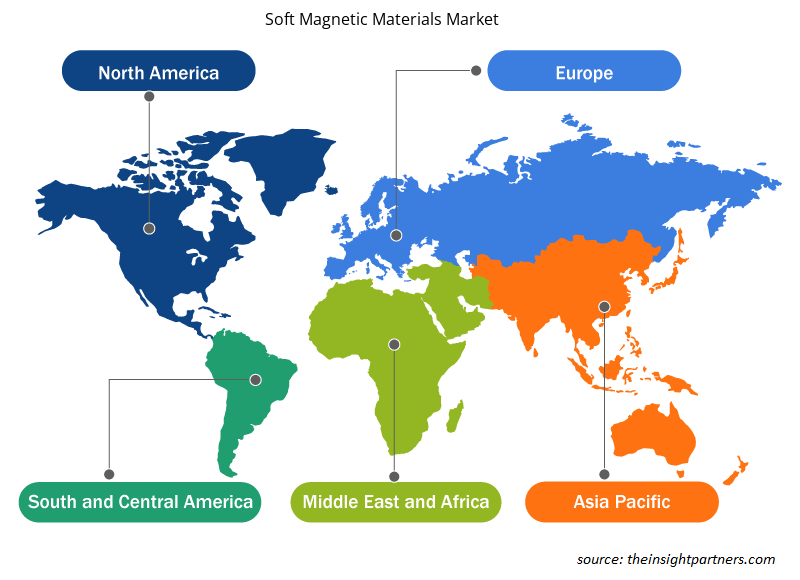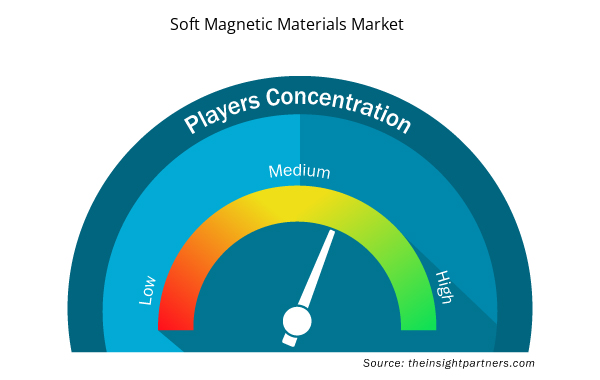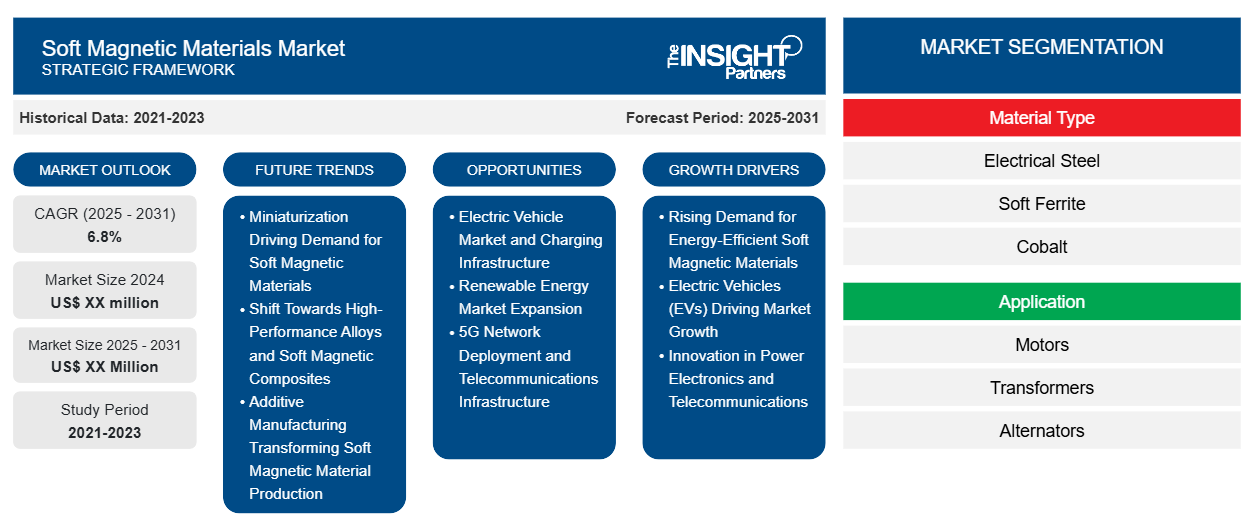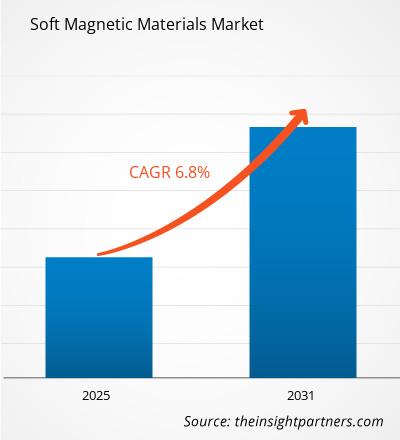من المتوقع أن يسجل سوق المواد المغناطيسية اللينة معدل نمو سنوي مركب بنسبة 6.8٪ من عام 2024 إلى عام 2031، مع توسع حجم السوق من XX مليون دولار أمريكي في عام 2024 إلى XX مليون دولار أمريكي بحلول عام 2031.
تم تقسيم التقرير حسب نوع المادة (الفولاذ الكهربائي، والفيرايت الناعم، والكوبالت، وغيرها). كما يقدم التقرير تحليلاً يعتمد على التطبيق (المحركات، والمحولات، والمولدات، وغيرها). ويغطي نطاق التقرير خمس مناطق: أمريكا الشمالية، وأوروبا، وآسيا والمحيط الهادئ، والشرق الأوسط وأفريقيا، وأمريكا الجنوبية والوسطى، والدول الرئيسية في كل منطقة. كما تم تقسيم التحليل العالمي على المستوى الإقليمي والدول الرئيسية. ويقدم التقرير القيمة بالدولار الأمريكي للتحليل والقطاعات المذكورة أعلاه.
غرض التقرير
يهدف تقرير سوق المواد المغناطيسية اللينة الصادر عن The Insight Partners إلى وصف المشهد الحالي والنمو المستقبلي وأهم العوامل الدافعة والتحديات والفرص. وسيوفر هذا رؤى لمختلف أصحاب المصلحة في الأعمال التجارية، مثل:
- مزودي/مصنعي التكنولوجيا: لفهم ديناميكيات السوق المتطورة ومعرفة فرص النمو المحتملة، وتمكينهم من اتخاذ قرارات استراتيجية مستنيرة.
- المستثمرون: إجراء تحليل شامل للاتجاهات فيما يتعلق بمعدل نمو السوق، وتوقعات السوق المالية، والفرص المتاحة عبر سلسلة القيمة.
- الهيئات التنظيمية: لتنظيم السياسات ومراقبة الأنشطة في السوق بهدف تقليل الانتهاكات والحفاظ على ثقة المستثمرين ودعم سلامة السوق واستقرارها.
تجزئة سوق المواد المغناطيسية اللينة
نوع المادة
- الفولاذ الكهربائي
- الفريت الناعم
- الكوبالت
طلب
- المحركات
- محولات
- المولدات
قم بتخصيص هذا التقرير ليناسب متطلباتك
ستحصل على تخصيص لأي تقرير - مجانًا - بما في ذلك أجزاء من هذا التقرير، أو تحليل على مستوى الدولة، وحزمة بيانات Excel، بالإضافة إلى الاستفادة من العروض والخصومات الرائعة للشركات الناشئة والجامعات
- احصل على أهم اتجاهات السوق الرئيسية لهذا التقرير.ستتضمن هذه العينة المجانية تحليلاً للبيانات، بدءًا من اتجاهات السوق وحتى التقديرات والتوقعات.
عوامل نمو سوق المواد المغناطيسية اللينة
- الطلب المتزايد على المواد المغناطيسية اللينة الموفرة للطاقة: التركيز المتزايد على أسواق كفاءة الطاقة الجماعية في الإلكترونيات الاستهلاكية والمحركات الكهربائية إلى الصناعات الثقيلة في توليد الطاقة سوق المواد المغناطيسية اللينة المتنامية. المواد المغناطيسية اللينة، والتي تشمل السبائك القائمة على الحديد، والفيرايت، والمركبات المغناطيسية اللينة، هي مكونات أساسية في الأجهزة التي تعزز تحسينات كفاءة الطاقة - بما في ذلك المحركات الكهربائية، والمحولات، والمحاثات، وإمدادات الطاقة. هناك طلب مرتفع من مختلف القطاعات الصناعية، وخاصة صناعات السيارات والإلكترونيات والأتمتة الصناعية، والتي تأتي بأفكار منخفضة استهلاك الطاقة مما يؤدي إلى بصمة كربونية أقل. ستعمل هذه المواد على تقليل خسائر القلب وتحسين الأداء في الأجهزة الموفرة للطاقة.
- المركبات الكهربائية (EVs) تقود نمو السوق: يبدو أن المركبات الكهربائية والمركبات الكهربائية الهجينة هي من أهم المساهمين في الطلب، حيث تُستخدم المواد المغناطيسية اللينة على نطاق واسع في المحركات الكهربائية وأنظمة الطاقة الإلكترونية. مع الحاجة إلى زيادة الكفاءة، فإن المركبات الكهربائية لديها طلب هائل على هذه الأنواع من المواد. يتم دمج الكفاءة والأداء الأمثل في أنظمة الدفع الكهربائية ومكونات النظام الإلكتروني الأخرى لإنشاء أنظمة للسيارات الكهربائية. إن زيادة لوائح الانبعاثات الأكثر صرامة والحوافز من قبل الحكومات في جميع أنحاء العالم نحو اعتماد المركبات الكهربائية من شأنه أن يسرع التغيير في قطاع السيارات، مما يؤدي إلى نمو هائل في سوق المواد المغناطيسية اللينة.
- الابتكار في مجال الإلكترونيات الكهربائية والاتصالات: سيستمر قطاع السيارات في الخضوع لتحول سريع مع الابتكارات في مجال الإلكترونيات الكهربائية، وخاصة مع الانتشار السريع لشبكات الجيل الخامس وأنظمة الطاقة المتجددة وحلول تخزين الطاقة، مما يخلق طلبًا هائلاً على المواد المغناطيسية اللينة المتقدمة. تعد المواد المغناطيسية اللينة المادة السائدة للمحثات والمحولات المستخدمة في إمدادات الطاقة ومعدات الاتصالات. إنها تساهم بشكل كبير في تحسين أداء نظام الطاقة: فهي تزيد من كفاءة عملية تحويل الطاقة مع انخفاض الخسائر عدة مرات؛ كما أنها تجعل من الممكن إنشاء أجهزة أكثر إحكاما وموثوقية. يساهم الطلب على المكونات عالية الأداء وكفاءة الطاقة في قطاعات مثل الاتصالات وتوليد الطاقة المتجددة (توربينات الرياح، ومحولات الطاقة الشمسية، وما إلى ذلك) في الحاجة إلى المواد المغناطيسية اللينة.
الاتجاهات المستقبلية لسوق المواد المغناطيسية اللينة
- التصغير يحرك الطلب على المواد المغناطيسية اللينة: المواد المغناطيسية اللينة هي النمو في الطلب على المكونات المصغرة والمتكاملة في إلكترونيات السيارات والإلكترونيات الاستهلاكية والأجهزة الطبية، من بين العديد من الأجهزة الأخرى. مع قيام الصناعات بجعل الأجهزة أصغر حجمًا وأكثر كفاءة، يستمر الطلب على المكونات الصغيرة ذات الأداء العالي في التطبيقات ذات المساحة المحدودة في الارتفاع. تشمل أهداف التصميم الأخرى محاثات الطاقة ذات الأداء العالي والمحولات وأجهزة الاستشعار المصنوعة من مواد مغناطيسية لينة. يستمر الطلب على الحلول المغناطيسية الأخف وزناً والأكثر إحكاما في تغذية النمو في الإلكترونيات، مع انتشار أكبر لمثل هذا النشاط في القطاع.
- التحول نحو السبائك عالية الأداء والمركبات المغناطيسية اللينة: يتم تحويل المواد المغناطيسية اللينة ذات الأداء العالي نحو السبائك والمركبات عالية الأداء. تتمتع السبائك والمواد المركبة المتقدمة بخصائص مغناطيسية أفضل وخسائر طاقة أقل واستقرار حراري محسن بشكل كبير، وتحل محل الفولاذ السيليكوني التقليدي تدريجيًا. اكتسبت المركبات المغناطيسية اللينة شعبية في التطبيقات التي تتطلب هندسة معقدة ذات أداء عالٍ. يصبح هذا الأمر ذا صلة خاصة في قطاعي السيارات والصناعة. ستعمل هذه المواد الجديدة على خفض خسائر القلب مع زيادة كفاءة هذه المركبات، مما يجعلها مرغوبة للغاية للتطبيقات التي تتطلب ترددات عالية الأداء بالإضافة إلى خسائر طاقة منخفضة.
- التصنيع الإضافي وتحويل إنتاج المواد المغناطيسية اللينة: بدأ التصنيع الإضافي، أو الطباعة ثلاثية الأبعاد، الآن في الإضافة إلى تصنيع المواد المغناطيسية اللينة، والتي تغير وجوهها. يتم تشكيل المواد المغناطيسية اللينة من خلال إنشاء أشكال وهياكل معقدة لا يمكن تحقيقها باستخدام تقنيات التصنيع التقليدية. بالنسبة للمواد المغناطيسية اللينة، تمكن الطباعة ثلاثية الأبعاد من تصميم النوى والعناصر بتعريفات مطلقة من حيث الخصائص المغناطيسية. مثل هذا الاتجاه قيم بشكل خاص في صناعات الطيران والسيارات والإلكترونيات الاستهلاكية، حيث تكون الحلول المتخصصة ضرورية لتحسين الأداء في الأجهزة المدمجة عالية الكفاءة.
فرص سوق المواد المغناطيسية اللينة
- سوق المركبات الكهربائية والبنية الأساسية للشحن: إن الطلب المتزايد على المركبات الكهربائية يجلب أيضًا مجالًا هائلاً للتطوير في المواد المغناطيسية اللينة في سوق السيارات وكذلك البنية الأساسية للشحن. إن الطلب على المحركات الكهربائية ومحولات الطاقة وأنظمة الشحن ذات الكفاءة المتزايدة يتناسب بشكل مباشر مع الطلب على المركبات الكهربائية. سيتم استخدام المواد المغناطيسية اللينة بشكل أساسي لتعزيز كفاءة المحرك وتقليل الخسائر وتسريع عملية الشحن. ويرجع هذا إلى حقيقة أنه مع العدد المتزايد من تركيبات المركبات الكهربائية، بما يتوافق مع مستوى التبني الذي بدأت هذه المركبات تتلقاه من المستهلكين بالإضافة إلى الدعم الأساسي لجميع عمليات الشحن الممكنة، تتكشف إمكانات هائلة لمنتجي المواد المغناطيسية اللينة.
- التوسع في سوق الطاقة المتجددة: مع اكتساب طاقة الرياح والطاقة الشمسية زخمًا متزايدًا، فهي في حاجة مستمرة إلى المزيد من المواد المغناطيسية اللينة لتوليد الطاقة ونقلها وتخزينها. على سبيل المثال، تم استخدام المولدات والمحولات ومحولات الطاقة لجعل أنظمة الطاقة أقوى وأكثر كفاءة. إن التطورات في تكنولوجيا الشبكة الذكية، والتي تتطلب أنظمة متطورة لإدارة الطاقة وتخزين الطاقة، تدفع الطلب على المواد المغناطيسية اللينة في مكونات الشبكة. إن النمو في البنية التحتية للطاقة المتجددة في جميع أنحاء العالم يمثل فرصة طويلة الأجل لمصنعي المواد المغناطيسية اللينة.
- نشر شبكات الجيل الخامس والبنية الأساسية للاتصالات: من المتوقع أن يؤدي نشر شبكات الجيل الخامس والمزيد من التوسعات في البنية الأساسية للاتصالات إلى خلق فرص جديدة للمواد المغناطيسية اللينة. ونظرًا لأن المواد المغناطيسية اللينة تلعب دورًا رئيسيًا في أنظمة إمداد الطاقة لمعدات الاتصالات، مثل محطات القاعدة وأجهزة التوجيه ومعالجات الإشارات، فإنها تقلل من خسائر الطاقة وتساهم في تحسين كفاءة العناصر التي تعمل بإشارات عالية التردد. ويؤدي الطلب المستمر على شبكات أسرع وأكثر موثوقية إلى تعزيز التوجه نحو مكونات مغناطيسية فعالة وعالية الأداء في تطبيقات الاتصالات.
رؤى إقليمية حول سوق المواد المغناطيسية اللينة
لقد قام المحللون في Insight Partners بشرح الاتجاهات والعوامل الإقليمية المؤثرة على سوق المواد المغناطيسية اللينة طوال فترة التوقعات بشكل شامل. يناقش هذا القسم أيضًا قطاعات سوق المواد المغناطيسية اللينة والجغرافيا في جميع أنحاء أمريكا الشمالية وأوروبا ومنطقة آسيا والمحيط الهادئ والشرق الأوسط وأفريقيا وأمريكا الجنوبية والوسطى.

- احصل على البيانات الإقليمية المحددة لسوق المواد المغناطيسية اللينة
نطاق تقرير سوق المواد المغناطيسية اللينة
| سمة التقرير | تفاصيل |
|---|---|
| حجم السوق في عام 2024 | XX مليون دولار أمريكي |
| حجم السوق بحلول عام 2031 | XX مليون دولار أمريكي |
| معدل النمو السنوي المركب العالمي (2025 - 2031) | 6.8% |
| البيانات التاريخية | 2021-2023 |
| فترة التنبؤ | 2025-2031 |
| القطاعات المغطاة | حسب نوع المادة
|
| المناطق والدول المغطاة | أمريكا الشمالية
|
| قادة السوق وملفات تعريف الشركات الرئيسية |
|
كثافة اللاعبين في سوق المواد المغناطيسية اللينة: فهم تأثيرها على ديناميكيات الأعمال
يشهد سوق المواد المغناطيسية اللينة نموًا سريعًا، مدفوعًا بالطلب المتزايد من المستخدم النهائي بسبب عوامل مثل تفضيلات المستهلك المتطورة والتقدم التكنولوجي والوعي المتزايد بفوائد المنتج. ومع ارتفاع الطلب، تعمل الشركات على توسيع عروضها والابتكار لتلبية احتياجات المستهلكين والاستفادة من الاتجاهات الناشئة، مما يؤدي إلى زيادة نمو السوق.
تشير كثافة اللاعبين في السوق إلى توزيع الشركات أو المؤسسات العاملة في سوق أو صناعة معينة. وهي تشير إلى عدد المنافسين (اللاعبين في السوق) الموجودين في مساحة سوق معينة نسبة إلى حجمها أو قيمتها السوقية الإجمالية.
الشركات الرئيسية العاملة في سوق المواد المغناطيسية الناعمة هي:
- أميس جنوب أفريقيا
- تقنيات أرنولد المغناطيسية
- شركة دايدو ستيل المحدودة
- GKN Sinter Metals
- شركة هيتاشي للمعادن المحدودة
إخلاء المسؤولية : الشركات المذكورة أعلاه ليست مرتبة بأي ترتيب معين.

- احصل على نظرة عامة على أهم اللاعبين الرئيسيين في سوق المواد المغناطيسية اللينة
نقاط البيع الرئيسية
- التغطية الشاملة: يغطي التقرير بشكل شامل تحليل المنتجات والخدمات والأنواع والمستخدمين النهائيين لسوق المواد المغناطيسية اللينة، مما يوفر صورة شاملة.
- تحليل الخبراء: تم تجميع التقرير على أساس الفهم العميق لخبراء الصناعة والمحللين.
- معلومات محدثة: يضمن التقرير أهمية الأعمال التجارية بسبب تغطيته للمعلومات الحديثة واتجاهات البيانات.
- خيارات التخصيص: يمكن تخصيص هذا التقرير لتلبية متطلبات العملاء المحددة وبما يتناسب مع استراتيجيات العمل بشكل مناسب.
وبالتالي، يمكن أن يساعد تقرير البحث حول سوق المواد المغناطيسية اللينة في تمهيد الطريق لفك شفرة وفهم سيناريو الصناعة وآفاق النمو. ورغم وجود بعض المخاوف المشروعة، فإن الفوائد الإجمالية لهذا التقرير تميل إلى التفوق على العيوب.
- التحليل التاريخي (سنتان)، السنة الأساسية، التوقعات (7 سنوات) مع معدل النمو السنوي المركب
- تحليل PEST و SWOT
- حجم السوق والقيمة / الحجم - عالميًا وإقليميًا وقطريًا
- الصناعة والمنافسة
- مجموعة بيانات Excel



Report Coverage
Revenue forecast, Company Analysis, Industry landscape, Growth factors, and Trends

Segment Covered
This text is related
to segments covered.

Regional Scope
North America, Europe, Asia Pacific, Middle East & Africa, South & Central America

Country Scope
This text is related
to country scope.
الأسئلة الشائعة
The growing adoption of additive manufacturing (3D printing) is expected to be the key market trend.
The report can be delivered in PDF/Word format, we can also share excel data sheet based on request.
On the basis of geography, the soft magnetic materials market is classified into North America, Europe, Asia Pacific, Middle East and Africa, and South and Central America
BASF SE, Thermo Fisher Scientific, Merck KGaA, Solvay SA, Jiangsu Jibao Chemical Co Ltd, Shandong Kaihua Chemical Co Ltd, Changshu New Tech Chemicals Co Ltd, Reagent Grade Chemical Corp, Fujian Zhongtai Chemical Co Ltd, and Lianyungang Yuran Chemical Co Ltd
The major factors driving the soft magnetic materials market are:
1. Rising Demand for Energy-Efficient Solutions.
2. Growth of Electric Vehicles (EVs) and Hybrid Electric Vehicles (HEVs).
The Soft Magnetic Materials Market is estimated to witness a CAGR of 6.8% from 2023 to 2031
Trends and growth analysis reports related to Chemicals and Materials : READ MORE..
The List of Companies
1. Ames SA
2. Arnold Magnetic Technologies
3. Daido Steel Co. Ltd
4. GKN Sinter Metals
5. Hitachi Metals Ltd.
6. Mate Co. Ltd.
7. SG Technologies
8. Sintex A/S
9. Steward Advanced Materials
10. Vacuumschmelze GmbH and C0. Kg
The Insight Partners performs research in 4 major stages: Data Collection & Secondary Research, Primary Research, Data Analysis and Data Triangulation & Final Review.
- Data Collection and Secondary Research:
As a market research and consulting firm operating from a decade, we have published and advised several client across the globe. First step for any study will start with an assessment of currently available data and insights from existing reports. Further, historical and current market information is collected from Investor Presentations, Annual Reports, SEC Filings, etc., and other information related to company’s performance and market positioning are gathered from Paid Databases (Factiva, Hoovers, and Reuters) and various other publications available in public domain.
Several associations trade associates, technical forums, institutes, societies and organization are accessed to gain technical as well as market related insights through their publications such as research papers, blogs and press releases related to the studies are referred to get cues about the market. Further, white papers, journals, magazines, and other news articles published in last 3 years are scrutinized and analyzed to understand the current market trends.
- Primary Research:
The primarily interview analysis comprise of data obtained from industry participants interview and answers to survey questions gathered by in-house primary team.
For primary research, interviews are conducted with industry experts/CEOs/Marketing Managers/VPs/Subject Matter Experts from both demand and supply side to get a 360-degree view of the market. The primary team conducts several interviews based on the complexity of the markets to understand the various market trends and dynamics which makes research more credible and precise.
A typical research interview fulfils the following functions:
- Provides first-hand information on the market size, market trends, growth trends, competitive landscape, and outlook
- Validates and strengthens in-house secondary research findings
- Develops the analysis team’s expertise and market understanding
Primary research involves email interactions and telephone interviews for each market, category, segment, and sub-segment across geographies. The participants who typically take part in such a process include, but are not limited to:
- Industry participants: VPs, business development managers, market intelligence managers and national sales managers
- Outside experts: Valuation experts, research analysts and key opinion leaders specializing in the electronics and semiconductor industry.
Below is the breakup of our primary respondents by company, designation, and region:

Once we receive the confirmation from primary research sources or primary respondents, we finalize the base year market estimation and forecast the data as per the macroeconomic and microeconomic factors assessed during data collection.
- Data Analysis:
Once data is validated through both secondary as well as primary respondents, we finalize the market estimations by hypothesis formulation and factor analysis at regional and country level.
- Macro-Economic Factor Analysis:
We analyse macroeconomic indicators such the gross domestic product (GDP), increase in the demand for goods and services across industries, technological advancement, regional economic growth, governmental policies, the influence of COVID-19, PEST analysis, and other aspects. This analysis aids in setting benchmarks for various nations/regions and approximating market splits. Additionally, the general trend of the aforementioned components aid in determining the market's development possibilities.
- Country Level Data:
Various factors that are especially aligned to the country are taken into account to determine the market size for a certain area and country, including the presence of vendors, such as headquarters and offices, the country's GDP, demand patterns, and industry growth. To comprehend the market dynamics for the nation, a number of growth variables, inhibitors, application areas, and current market trends are researched. The aforementioned elements aid in determining the country's overall market's growth potential.
- Company Profile:
The “Table of Contents” is formulated by listing and analyzing more than 25 - 30 companies operating in the market ecosystem across geographies. However, we profile only 10 companies as a standard practice in our syndicate reports. These 10 companies comprise leading, emerging, and regional players. Nonetheless, our analysis is not restricted to the 10 listed companies, we also analyze other companies present in the market to develop a holistic view and understand the prevailing trends. The “Company Profiles” section in the report covers key facts, business description, products & services, financial information, SWOT analysis, and key developments. The financial information presented is extracted from the annual reports and official documents of the publicly listed companies. Upon collecting the information for the sections of respective companies, we verify them via various primary sources and then compile the data in respective company profiles. The company level information helps us in deriving the base number as well as in forecasting the market size.
- Developing Base Number:
Aggregation of sales statistics (2020-2022) and macro-economic factor, and other secondary and primary research insights are utilized to arrive at base number and related market shares for 2022. The data gaps are identified in this step and relevant market data is analyzed, collected from paid primary interviews or databases. On finalizing the base year market size, forecasts are developed on the basis of macro-economic, industry and market growth factors and company level analysis.
- Data Triangulation and Final Review:
The market findings and base year market size calculations are validated from supply as well as demand side. Demand side validations are based on macro-economic factor analysis and benchmarks for respective regions and countries. In case of supply side validations, revenues of major companies are estimated (in case not available) based on industry benchmark, approximate number of employees, product portfolio, and primary interviews revenues are gathered. Further revenue from target product/service segment is assessed to avoid overshooting of market statistics. In case of heavy deviations between supply and demand side values, all thes steps are repeated to achieve synchronization.
We follow an iterative model, wherein we share our research findings with Subject Matter Experts (SME’s) and Key Opinion Leaders (KOLs) until consensus view of the market is not formulated – this model negates any drastic deviation in the opinions of experts. Only validated and universally acceptable research findings are quoted in our reports.
We have important check points that we use to validate our research findings – which we call – data triangulation, where we validate the information, we generate from secondary sources with primary interviews and then we re-validate with our internal data bases and Subject matter experts. This comprehensive model enables us to deliver high quality, reliable data in shortest possible time.


 احصل على عينة مجانية لهذا التقرير
احصل على عينة مجانية لهذا التقرير